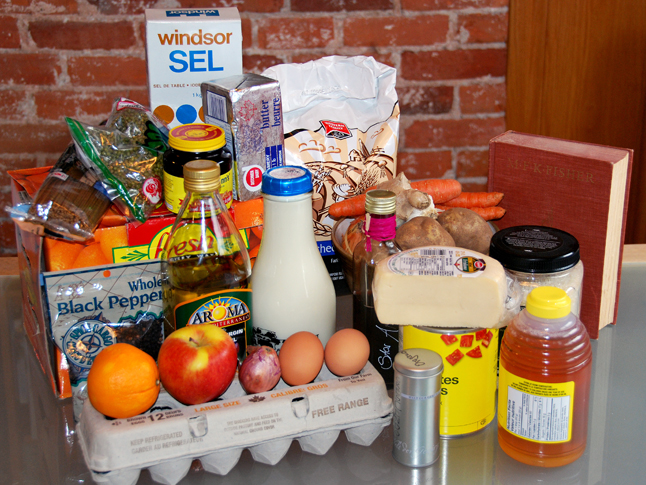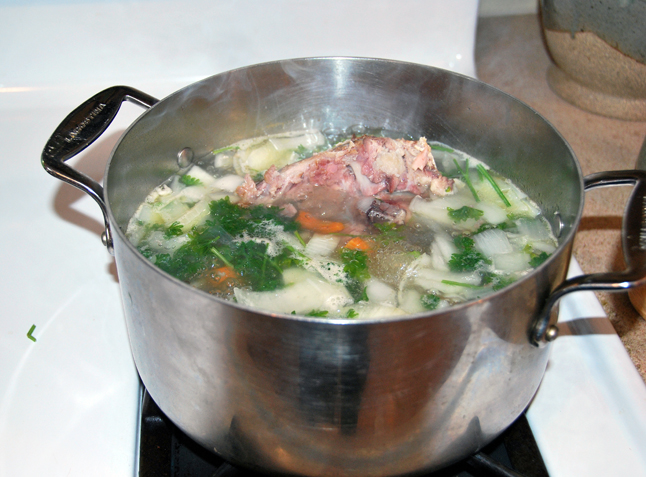
The first writer to write about eating and food as opposed to penning recipes was M.F.K. Fisher, an American who wrote a How to Cook a Wolf, a book about living in Europe in the 1930s. One of her most inspired pieces describes eating mandarin orange segments peeled and left sitting on a radiator until they were dry-roasted on the outside and plump and hot inside. Such is the minimalist succulence that inspired yours truly.
Much as all of us would adore to nip out each day for filet mignon, Portobello mushrooms and a bottle of 1932 Margaux, there are days — even months — when we’re wading through drifts of snow and bills too high to make it easy to stock up on les paniers de préference.
Here are some tips condensed from Fisher’s book about how to greet the wolf at the door, and a list of ingredients that will keep you alive through the lean mean month of January.
The Eco-Cook Swoops Again
- Cook two times the rice, potatoes or spaghetti that you need. Same amount of heat but with zapping potential less power-consumptive than the original cook time. This works well for wood-stove chefs, or campers on a sterno.
- Bake or roast with every inch of the oven full: toast nuts, bake potatoes or apples, make melba toast or pita chips or old bread, throw in a batch of cookies or muffins.
- Instead of buying meat per meal, buy a roast for the week, or a half a ham or a chicken. People eat less with two slices than with a whole steak or breast, and you can use the leftovers and bones for the rest of the week in casseroles and soups.
- Keep stale bread for crumbs. If you haven’t got a blender or food processor, a paper bag and a hammer can crush the hunks of hard bread. You can cook small pieces of fish, chicken or meat in crumbs; make salmon burgers or crab cakes—should you be so lucky as to catch a crab; or roll cheese in egg and crumbs and fry gently, for protein add-on to a baked potato.
- Keep an empty vodka bottle in the fridge, and keep veggie cooking water, bits of fruit juice and lemon zest in it for soups, for when you don’t have broth. (Empty it once a week — this stuff will eventually go sour.)
- Rely on Adam’s Ale as an appetizer. Drinking water is good for us, and carves a nifty line through everyone’s appetite. An 8-ounce glass of water before meals means you’re eating from hunger, not thirst, one of the big factors in over-eating.
- Encourage everyone in your household to sit down together to eat, and light candles for atmosphere. Our electricity is relatively cheap, but it’s still a cost. It’s less expensive to heat food once, do dishes once, open the fridge five times than ten. Also, one purpose of cooking (rather than foraging, as is now often the habit in family life) is social: getting together to share food encourages conversation and communication. Timetables and work pressures oppose us here, but even once or twice a week is better than never.
- Bake bread.
- Rely on soup.
- Love an egg.

The Revisionist’s Food Basket for Red Riding Hood as she defeats the wolf
- milk or milk powder
- salt
- pepper
- tea and/or coffee
- 5 lb carrots
- 10 lb onions
- 10 lb potatoes
- dried split peas
- 5 lb flour
- honey
- butter or margarine or olive oil
- eggs
- old white cheddar cheese
- yeast or baking powder
- rice
- spaghetti
- tinned tomatoes
- balsamic vinegar
- oregano
- garlic
- mustard (the Dijon kind)
Red Riding Hood and Granny can eat well from this list. Not luxuriously, but not monotonously. After a while, they miss greens and fresh fruit, so gather the pennies from the jar under the dead wolf and splurge, buying broccoli, lettuce, green beans, cabbage, oranges and apples. They want great flavour, so trip out to Crescendo for balsamic and oil and oregano. They plan to go to the Thursday Community Centre Market Jan 13 for the veggies. And with this list they produce, as well as bread and muffins, the following yummies that they distribute to all the little folk in the forest:
Potato Soup
Onion Soup
Split Pea Soup – Habitant Style
Tomato Sauce or soup
Baked Potato, Fried Onions and Poached Eggs
Savory Omelette and Oven Fries
Poached Eggs and Onion Gratin
Crepes with potato, onion and cheese stuffing
Pancakes with honey
Tobacco onions (slow fried onions until crispy)
Spaghetti with Home-made Tomato Sauce
Fried rice
At a loss for how to make these, Red Riding Hood goes to see Gwen at Castle Joe Books on Second Street for a great selection of recycled cookbooks at recyle prices, and looks up recipes at www.epicurious.com. She makes a huge pot of Split Pea Soup from the recipe below — a version of the old Habitant Soup in tins, but without the high sodium delivery, and tasting much fresher. Granny finds a bone-in ham in the wolf’s knapsack (always better than the boned variety, and easy now that spiral-cut ham is available.) RRH simmers the ham in 1 litre apple cider with 2 onions for an hour, then bakes it for another in a 350 F oven, covered with a mix of mustard and brown sugar, basting with the cider, and saving the bone.
Next Red Riding Hood checks her equipment, and decides that a trip to Chantilly is in order. Apart from a decent frying pan, a soup-pot and several large stainless steel bowls, the most useful piece of equipment for the novice eco-cook and one that will return innumerable dollars for its price of $35 to $50, is a blender. With this, soups are a breeze, and you can substitute whizzed veggies for cream and expensive sauces. A glass rather than plastic jar on the blender retains no vestigial aromas of yesterday’s nosh.


Split Pea Soup
Serves 2 for a week, or 10-12 once
Start the night before.
Equipment: a large soup-pot, colander, sieve, and two large bowls.
Ingredients
1 hambone, with meaty bits (failing a hambone, use a thick ham slice or 200 grams pancetta from the deli counter, cubed, fried and drained so the fat comes out.)
16 cups water
1 knob ginger
1 stalk celery
1 orange, mandarin or lemon
2 carrots
2 cloves garlic
1 package split peas ( 450 grams)
8 onions
1 potato
salt and pepper
1 tbsp balsamic vinegar
1 tbsp Dijon mustard
1 tsp sugar
1 tsp or more to taste, hot chili paste (optional)
The day before you make the soup, clean the split peas in several rinses of water (until the water doesn’t froth any more — heaven knows what the froth is, but you don’t need it’s turbulent grime) and then put the peas in a large bowl and add water to more than cover. Let sit for 12-24 hours. Drain well and rinse again.

Simmer the hambone in 10 cups of water, with the garlic and ginger sliced into the water. Add the orange or lemon, cut in two; it helps overcome the somewhat unpleasant smell of a cooking bone. Bring to a boil, then reduce the heat and simmer until the meat falls off the hambone and the marrow is soft enough to dig out with a small spoon. Continue to simmer until the marrow is absorbed. (It’s the marrow that gives the soup its really delicious flavour, unobtainable any other way.) Cool 10 minutes, then drain into a large bowl, reserving everything.
Cut the meat off the bones, and dice it into small pieces, removing every shred of fat.
Strain the broth through a fine sieve, and reserve.
Dice the onions, potato, celery and carrots, mustard and simmer them in the pot with ½ cup of the broth until the onions turn transparent and begin to brown a little. Add the ham and continue to stir-fry the mix. When the whole thing looks appetizing, stir in the split peas and add the rest of the ham broth. You should have about 8-10 cups. Add another 2-3 cups of water.
Simmer this for 1-2 hours, until the peas are mushy and the other vegetables well cooked. Add salt and pepper to taste. If you want a spicy soup — not traditional in pea soup — add chili paste.
This is a hearty, filling soup, very satisfying after being out in the snow, whether shoveling, skiing or just trudging around town. Add a glass or beer — Mount Begbie or your own brew — honest bread, and cheese if you have some. An apple or mandarin is the perfect dessert. A great thermos lunch for skiers at Mount Macpherson or RMR.



